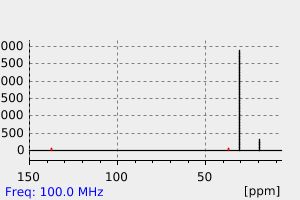(E)-2,2,3,4,5,5-六甲基-3-己烯 | 54290-40-3
中文名称
(E)-2,2,3,4,5,5-六甲基-3-己烯
中文别名
——
英文名称
trans-2,2,3,4,5,5-Hexamethyl-3-hexen
英文别名
(E)-2,3-Di-tert-butyl-2-butene;(E)-2,2,3,4,5,5-hexamethylhex-3-ene
CAS
54290-40-3
化学式
C12H24
mdl
——
分子量
168.323
InChiKey
UKVHFKANOLLXHC-MDZDMXLPSA-N
BEILSTEIN
——
EINECS
——
-
物化性质
-
计算性质
-
ADMET
-
安全信息
-
SDS
-
制备方法与用途
-
上下游信息
-
文献信息
-
表征谱图
-
同类化合物
-
相关功能分类
-
相关结构分类
计算性质
-
辛醇/水分配系数(LogP):5.5
-
重原子数:12
-
可旋转键数:2
-
环数:0.0
-
sp3杂化的碳原子比例:0.83
-
拓扑面积:0
-
氢给体数:0
-
氢受体数:0
SDS
上下游信息
反应信息
-
作为反应物:描述:参考文献:名称:Lenoir,D., Chemische Berichte, 1978, vol. 111, p. 411 - 414摘要:DOI:
-
作为产物:描述:参考文献:名称:Lenoir,D., Chemische Berichte, 1978, vol. 111, p. 411 - 414摘要:DOI:
文献信息
-
Reaction of Crowded Olefins with Bromine. A Comparison of the Strained (E)-2,2,3,4,5,5-Hexamethylhex-3-ene with the Sterically Hindered Tetraisobutylethylene作者:Giuseppe Bellucci、Roberto Bianchini、Cinzia Chiappe、Dieter Lenoir、Abdul AttarDOI:10.1021/ja00128a010日期:1995.6(E)-2,2,3,4,5,5-Hexamethylhex-3-ene (HMH, 2) reacts with Br-2 in chlorinated hydrocarbon solvents to give 3-bromo-2-tert-butyl-3,4,4-trimethylpentene (4), which is dehydrobrominated to 2,3-di-tert-butyl-1,3-butadiene (5). The first product of the interaction of the title olefin and Br-2 in 1,2-dichloroethane is a 1:1 CTC having K-f = 84(0.3) M(-1) at 25 degrees C, Delta H = -5.7(0.4) kcal mol(-1), and Delta S = -10.3(1.3)eu in this solvent. This probably evolves to a second CTC of 1:2 stoichiometry, which ionizes directly to a bromonium-tribromide ion pair. Removal of an H+ from the bromonium ion by the counteranion gives the allylic bromide 4. Kinetic investigations using 2-H6 and its 3,4-bis(trideuteriomethyl) derivative 2-D6 show a primary kinetic isotope effect k(H)/k(D) = 2.17(0.25) at 25 degrees C, which decreases with increasing temperature, showing that the deprotonation step is at least partially rate determining. A similar conclusion holds for the reaction in acetic acid, where a k(H)/k(D) = 2.05(0.1) at 25 degrees C is observed. This requires that the formation of the bromonium ion intermediate is a reversible process, as for the analogous reaction of tetraisobutylethylene (TIBE, 1) with Br-2. The apparent activation energy for the reaction of 2-H6 in acetic acid, E(a(obsd)) = 1.93(0.06) kcal mol(-1), is much lower than that for the reaction of TIBE (1), E(a(obsd)) = 15.65(1.22) mol(-1). This is mainly attributable to steric strain present in the olefin HMH, 2,which is relieved in in the rate-determining transition state.(E)-2,2,3,4,5,5-六甲基己烯 (HMH, 2)与Br-2在氯代烷烃溶剂中反应,得到3-溴-2-tert-丁基-3,4,4-三甲基戊烯(4),随后被脱溴生成2,3-二tert-丁基-1,3-丁二烯(5)。该烯烃与Br-2在1,2-二氯乙烷的反应首产物为1:1的比例循环转化物(CTC),其稳定自由能为 K-f = 84(0.3) M⁻¹,ΔH = -5.7(0.4) kcal mol⁻¹,ΔS = -10.3(1.3) eu。这种情况下,可能转化为1:2 的第二步产物,该产物直接形成溴化溴onium-三角溴离子对。通过加入反离子消除溴onium离子中的H+,从而得到邻位溴化物 4。通过使用2-H6及其3,4-二(D-TMS)甲基取代的溴化物 2-D6来进行动力学研究,发现在25°C时,一级动压效应 k(H)/k(D) = 2.17(0.25),并且随着温度的升高而减小,这表明解离步骤至少部分影响了反应速率。在酸性条件下的情况类似,观察到 k(H)/k(D) = 2.05(0.1)。由此可知,溴离子中间体的形成过程应为可逆的,例如对于以正丁基丙烯为模型的类似反应。在酸性条件下,2-H6的动压能 E(a(obsd)) = 1.93(0.06) kcal mol⁻¹较差于 TIB.[Hm,这里的 E(a(obsd)) = 15.65(1.22) kcal mol⁻¹,这主要归因于烯烃 HMH, 2中的立体阻碍,这部分障碍在确定步的反应速率特征中被缓解。
-
Doering, William v. E.; Roth, Wolfgang R.; Bauer, Frank, Chemische Berichte, 1989, vol. 122, p. 1263 - 1276作者:Doering, William v. E.、Roth, Wolfgang R.、Bauer, Frank、Breuckmann, Rolf、Ebbrecht, Thomas、at al.DOI:——日期:——
-
Hellmann, Goetz; Hellmann, Siegried; Beckhaus, Hans-Dieter, Chemische Berichte, 1982, vol. 115, # 10, p. 3364 - 3383作者:Hellmann, Goetz、Hellmann, Siegried、Beckhaus, Hans-Dieter、Ruechardt, ChristophDOI:——日期:——
-
A New Highly Stereoselective Rearrangement of Acyclic Tertiary Organoboranes: An Example of Highly Stereoselective Remote C−H Activation作者:Hamid Laaziri、Lars O. Bromm、Frédéric Lhermitte、Ruth M. Gschwind、Paul KnochelDOI:10.1021/ja9843977日期:1999.7.1
-
Bianchini, Roberto; Chiappe, Cinzia; Lenoir, Dieter, Gazzetta Chimica Italiana, 1995, vol. 125, # 10, p. 453 - 458作者:Bianchini, Roberto、Chiappe, Cinzia、Lenoir, Dieter、Meyer, BerndDOI:——日期:——
表征谱图
-
氢谱1HNMR
-
质谱MS
-
碳谱13CNMR
-
红外IR
-
拉曼Raman
-
峰位数据
-
峰位匹配
-
表征信息
同类化合物
高密聚乙烯
香叶醇
顺式3-甲基-2-己烯
顺式-5-癸烯
顺式-5-甲基-2-己烯
顺式-5-庚烯-1-炔
顺式-4-癸烷
顺式-4-甲基-2-戊烯
顺式-4-甲基-2-戊烯
顺式-3-癸烯
顺式-3-甲基-3-己烯
顺式-3-甲基-2-庚烯
顺式-3-戊烯-1-炔
顺式-3,4-二甲基-3-己烯
顺式-3,4-二甲基-2-戊烯
顺式-3,4-二甲基-2-戊烯
顺式-2-甲基-3-己烯
顺式-2-壬烯
顺式-2-丁烯-D1
顺式-1.1.1-三甲基-2-丁烯
顺式-1-甲基-2-环丙基乙烯
顺式-1-甲基-2-乙烯基环戊烷
顺式-1-环戊基-1-辛烯
顺式-1-氘代-3-甲基-1-丁烯
顺式-(9ci)-2,3,3a,7a-四氢-4-(1-甲基乙基)-1H-茚
顺式-(2-丁烯基)环丙烷
顺式,顺式-2,4-己二烯
顺-环辛烯
顺-9-二十一碳烯
顺-6-十三碳烯
顺-5-甲基-1,3,6-庚三烯
顺-4-辛烯
顺-4-壬烯
顺-3-辛烯
顺-3-甲基-2-戊烯
顺-3-壬烯
顺-3-十三碳烯
顺-2-辛烯
顺-2-癸烯
顺-2-戊烯
顺-2-庚烯
顺-2-己烯
顺-2-丁烯
顺-2,2-二甲基-3-己烯
顺-1,3-戊二烯
顺,顺-1,9-环十六烷二烯
顺,顺,顺-环癸-1,3,5-三烯
间戊二烯
间二(4-吡啶基)苯
镁,二-2-丁烯基-







